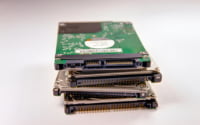How to Remove File Systems with ‘umount’ Command

Ever found yourself puzzled on how to safely unmount a file system in Linux? You’re not alone. Many users find themselves in a similar situation. Think of the ‘umount’ command in Linux as a careful librarian returning a book to its shelf, it helps you safely remove file systems without causing any damage.
This guide will walk you through the basics to more advanced uses of the ‘umount’ command. We’ll cover everything from the basic usage of ‘umount’, advanced techniques, alternative approaches, to troubleshooting common issues.
So, let’s dive in and start mastering the ‘umount’ command in Linux!
TL;DR: How Do I Use the ‘umount’ Command in Linux?
To unmount a file system in Linux, you use the
'umount'command followed by the directory where it has been mounted. The basic syntax would be,umount /path/to/file_system.
Here’s a simple example:
umount /mnt/my_usb
In this example, we’ve used the ‘umount’ command to unmount the file system that was previously mounted at the directory ‘/mnt/my_usb’. This is a basic way to use the ‘umount’ command in Linux, but there’s much more to learn about unmounting file systems safely and effectively.
Continue reading for more detailed information and advanced usage scenarios.
Table of Contents
- Getting Started with ‘umount’ Command
- Advanced Use of ‘umount’ Command
- Exploring Alternatives: Beyond ‘umount’
- Navigating Challenges: Troubleshooting ‘umount’
- Understanding File Systems, Mounting and Unmounting
- The ‘umount’ Command: A Staple in System Administration
- Wrapping Up: Mastering the ‘umount’ Command in Linux
Getting Started with ‘umount’ Command
The ‘umount’ command in Linux is used to unmount file systems. Whenever you mount a file system, it’s important to ensure that you unmount it properly when you’re done. This helps to prevent data corruption and other issues.
Let’s take a look at a simple example of how to use the ‘umount’ command:
mount /dev/sdb1 /mnt/my_usb
ls /mnt/my_usb
umount /mnt/my_usb
# Output:
# file1.txt
# file2.txt
In the above example, we first mount the file system located at ‘/dev/sdb1’ to the directory ‘/mnt/my_usb’. Then we list the files in the directory ‘/mnt/my_usb’ using ‘ls’ command, which shows ‘file1.txt’ and ‘file2.txt’. After we’re done, we unmount the file system using the ‘umount’ command.
One of the key advantages of the ‘umount’ command is that it ensures all pending changes to the file system are written and that the file system is in a consistent state before it’s unmounted. This is crucial for preventing data loss or corruption.
However, a potential pitfall to be aware of is that the ‘umount’ command will fail if the file system is busy, that is, if there are files that are open or processes that are using the file system. In such cases, you will need to close any open files or stop any processes using the file system before you can unmount it.
Advanced Use of ‘umount’ Command
As you become more comfortable with the basic ‘umount’ command, you’ll find that its true power lies in its advanced features. ‘umount’ command’s flexibility allows it to handle more complex unmounting tasks, such as unmounting different types of file systems and using different options.
Before we dive into the advanced usage of ‘umount’, let’s familiarize ourselves with some of the command-line arguments or flags that can modify the behavior of the ‘umount’ command. Here’s a table with some of the most commonly used ‘umount’ arguments.
| Argument | Description | Example |
|---|---|---|
-a | Unmount all file systems in /etc/mtab | umount -a |
-t | Limit the unmount action to certain types of file systems | umount -t nfs |
-n | Unmount without writing in /etc/mtab | umount -n /mnt/my_usb |
-r | Try to remount read-only if unmounting fails | umount -r /mnt/my_usb |
-l | Lazy unmount, detach the filesystem now and cleanup things later | umount -l /mnt/my_usb |
-f | Force unmount in case of an unreachable NFS system | umount -f /mnt/my_nfs |
-v | Verbose mode | umount -v /mnt/my_usb |
-h | Display help message and exit | umount -h |
-V | Output version information and exit | umount -V |
Now that we have a basic understanding of ‘umount’ command line arguments, let’s dive deeper into the advanced use of ‘umount’.
Using the -a and -t options
The -a option tells ‘umount’ to unmount all file systems listed in /etc/mtab. This can be particularly useful when you want to unmount multiple file systems at once.
umount -a
The -t option allows you to limit the unmount action to certain types of file systems. For example, you might want to unmount only NFS file systems:
umount -t nfs
Using the -l (Lazy Unmount) Option
The -l option is used for a ‘lazy’ unmount. This detaches the filesystem immediately, allowing the cleanup process to occur in the background. This is useful when the filesystem is busy and cannot be unmounted.
umount -l /mnt/my_usb
Using the -f (Force) Option
The -f option forces the unmount in the case of an unreachable NFS system. This option can lead to data loss in certain situations and should be used with caution.
umount -f /mnt/my_nfs
The ‘umount’ command in Linux is a powerful tool with a variety of options to help you manage your file systems. With these advanced options, you can handle complex unmounting tasks with ease.
Exploring Alternatives: Beyond ‘umount’
While the ‘umount’ command is a powerful tool for managing file systems in Linux, there are alternative methods that can be used to unmount file systems. These include using the ‘fuser’ command and third-party utilities. These alternatives can be particularly useful in scenarios where ‘umount’ may not be the optimal solution.
Using the ‘fuser’ Command
The ‘fuser’ command in Linux is a utility for identifying processes using files or sockets. It can be used to find out which processes are preventing a file system from being unmounted.
Here’s an example of how you can use ‘fuser’ to identify and kill processes that are using a file system:
fuser -muv /mnt/my_usb
fuser -mk /mnt/my_usb
# Output:
# USER PID ACCESS COMMAND
# /mnt/my_usb: root 12345 F.... process1
# root 67890 F.... process2
In the above example, the ‘-muv’ option shows the user (‘USER’), process ID (‘PID’), and the command (‘COMMAND’) of each process using the file system at ‘/mnt/my_usb’. The ‘-mk’ option then kills these processes.
Using Third-Party Utilities
There are also third-party utilities that can be used to unmount file systems in Linux. These utilities often provide a graphical user interface (GUI) and can be easier to use for those who are not comfortable with the command line.
One popular third-party utility is ‘GParted’, a free partition editor that allows you to resize, move, and manage disk partitions. With GParted, you can unmount a file system by right-clicking on the partition and selecting ‘Unmount’.
While these alternative methods can be useful, they come with their own advantages and disadvantages. The ‘fuser’ command, for example, can be a powerful tool for managing processes, but it can also be dangerous if used improperly. Third-party utilities, on the other hand, can be easier to use but may not offer the same level of control as command-line tools.
While ‘umount’ is a powerful command, like any tool, it can sometimes present challenges. One of the most common issues users encounter when using ‘umount’ is the ‘target is busy’ error. This error occurs when there are open files or running processes on the file system you’re trying to unmount. Let’s explore how to navigate this and other potential issues.
Dealing with the ‘Target is Busy’ Error
When you see the ‘target is busy’ error message, it means that there are still processes using the file system you’re trying to unmount. You can use the ‘fuser’ command to identify and terminate these processes.
umount /mnt/my_usb
fuser -muv /mnt/my_usb
fuser -mk /mnt/my_usb
umount /mnt/my_usb
# Output:
# umount: /mnt/my_usb: target is busy.
# USER PID ACCESS COMMAND
# /mnt/my_usb: root 12345 F.... process1
# root 67890 F.... process2
# umount: /mnt/my_usb: unmounted
In the above example, the initial attempt to unmount ‘/mnt/my_usb’ fails with the ‘target is busy’ error. We then use ‘fuser -muv’ to identify the processes using ‘/mnt/my_usb’, and ‘fuser -mk’ to terminate these processes. After this, we can successfully unmount ‘/mnt/my_usb’.
The ‘umount: not mounted’ Error
Another common error is ‘umount: not mounted’, which occurs when you try to unmount a file system that isn’t currently mounted. This can happen if you mistype the file system’s mount point or if the file system was already unmounted.
umount /mnt/my_usb
umount /mnt/my_usb
# Output:
# umount: /mnt/my_usb: unmounted
# umount: /mnt/my_usb: not mounted.
In this example, the first ‘umount’ command successfully unmounts ‘/mnt/my_usb’. However, the second ‘umount’ command fails with the ‘not mounted’ error because ‘/mnt/my_usb’ is no longer mounted.
Understanding these common issues and how to troubleshoot them will help you use the ‘umount’ command more effectively. Remember, the key to successful unmounting is ensuring that no processes are using the file system and that the file system is indeed mounted.
Understanding File Systems, Mounting and Unmounting
To fully grasp the ‘umount’ command in Linux, it’s crucial to understand the basics of file systems, and the concepts of mounting and unmounting.
File Systems in Linux
A file system, in simple terms, is the way files are stored and organized on a storage device. Linux supports a variety of file systems, such as ext4, XFS, Btrfs, and NFS, each with its own set of features and benefits.
Mounting and Unmounting
In Linux, before a file system can be accessed, it needs to be ‘mounted’ onto a directory in the existing directory tree. This ‘mount point’ then serves as the access point to the file system. Conversely, ‘unmounting’ is the process of detaching the file system from the directory tree, making it inaccessible until it’s mounted again.
Here’s a simple example of mounting and unmounting a file system:
mount /dev/sdb1 /mnt/my_usb
ls /mnt/my_usb
umount /mnt/my_usb
# Output:
# file1.txt
# file2.txt
In the above example, we first mount the file system located at ‘/dev/sdb1’ to the directory ‘/mnt/my_usb’. We then list the files in the directory ‘/mnt/my_usb’ using ‘ls’ command, which shows ‘file1.txt’ and ‘file2.txt’. After we’re done, we unmount the file system using the ‘umount’ command.
Understanding these fundamental concepts is key to mastering the ‘umount’ command and effectively managing file systems in Linux.
The ‘umount’ Command: A Staple in System Administration
The ‘umount’ command, while simple in its essence, plays a vital role in system administration and file management in Linux. Its importance extends beyond just unmounting file systems.
‘umount’ in System Administration
In system administration, the ‘umount’ command is frequently used when updating or modifying file systems, performing backups, or when detaching storage devices. It ensures that all data is properly written to the file system, preventing data corruption and preserving the integrity of the system.
‘umount’ and File Management
In terms of file management, ‘umount’ allows for the safe removal of file systems, ensuring that no data is lost or corrupted. It’s an essential command to know for anyone working with Linux file systems.
Exploring Related Concepts
The ‘umount’ command is just one piece of the larger puzzle of managing file systems in Linux. To gain a deeper understanding, it’s worth exploring related concepts such as disk partitioning, file system types, and mount points.
Disk partitioning involves dividing a disk into one or more separate areas, each of which can be formatted with a different file system. Understanding different file system types, such as ext4, XFS, and Btrfs, can help you choose the best file system for your needs. Finally, understanding mount points can help you effectively manage where and how file systems are accessed.
Further Resources for Mastering ‘umount’ and Linux File Systems
Here are some resources that can help you dive deeper into the world of Linux file systems and the ‘umount’ command:
- Linux File System Basics: This guide provides an overview of the Linux file system, including how to navigate and manipulate it.
Understanding Linux File Systems: This article dives into the details of the ext4 file system, one of the most commonly used file systems in Linux.
Managing Partitions with sfdisk: This tutorial shows you how to manage disk partitions using the sfdisk command in Linux.
Wrapping Up: Mastering the ‘umount’ Command in Linux
In this comprehensive guide, we’ve delved into the ‘umount’ command in Linux, a crucial tool for managing file systems. We’ve explored its usage, from basic to advanced, and discussed its relevance in system administration and file management.
We began with the basics, understanding the ‘umount’ command and how to use it to safely unmount file systems. We then delved into more advanced usage, exploring various options that the ‘umount’ command provides for handling complex unmounting tasks. We also discussed alternative approaches to unmounting file systems, such as using the ‘fuser’ command or third-party utilities.
Along the way, we tackled common issues users may encounter when using ‘umount’, such as the ‘target is busy’ error, and provided solutions and workarounds for each. We also took a step back to understand the fundamentals of file systems, and the concepts of mounting and unmounting, which underlie the ‘umount’ command.
Here’s a quick comparison of the methods we’ve discussed:
| Method | Pros | Cons |
|---|---|---|
| ‘umount’ | Robust, supports many options | May fail if file system is busy |
| ‘fuser’ | Can identify and terminate processes using file system | Can be dangerous if used improperly |
| Third-Party Utilities | Easy to use, often provide GUI | May not offer same level of control |
Whether you’re just starting out with the ‘umount’ command, or you’re looking to deepen your understanding, we hope this guide has been a valuable resource. The ‘umount’ command is a powerful tool in your Linux toolkit, equipping you to effectively manage file systems and ensure data integrity. Happy unmounting!


